Aikibatto 3 DetailsShiho HIDARI
DetailsAspects and considerations already treated in a previous exercise of Aikibatto, are omitted here.Shiho, four directions, is commented in the text on MAE. Hidari, left side, is the third of the four Shiho, with uke coming at tori from the left. The position of uke could be one behind the corner of a building, in which case a movement to uke's right is awkward — therefore not used here. Compared to the former exercises, MAE and USHIRO, this one uses a more flowing sword move, as well as another chiburi and noto.
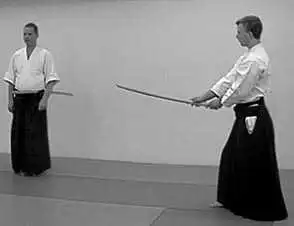 Starting position. Tori at left, uke at right. In the starting position, tori and uke are placed in sort of an L-formation, where tori has the shorter and uke the longer distance to their meeting point. It is at a right foot step that tori reaches this meeting point, in front of uke, and at this moment uke begins advancing. At that time, too, or immediately thereafter, tori turns.
Putting the feet together, almost always when there is time for it, I find a good way of remaining in balance, and having the most numerous options for what to do next. For example, when uke is very near, it may be practical for tori to have one foot step back when doing a cut, but when uke is more distant, tori needs to take a step forward to reach with a cut. This choice can be made instantly from the feet-together position. In movement three, uke has raised the sword at least partly toward jodan kamae, when tori starts the draw — not to be in each other's way. This is, of course, also the case in the nuki tsuke move of MAE and USHIRO, but in this exercise the timing may prove to be the most tricky one for tori.
The most difficult part with flowing sword moves between one technique and the next, is to direct the edge correctly also for the second technique. For this to be the case, one needs to make any kamae — however quickly passing — a moment to establish anew a proper sword grip and aim, which will more or less automatically adjust the direction of the edge of the sword. Actually, any position with the sword should, in this fashion, be a sort of kamae, where the blade is gripped so that it can immediately perform a correct cut. Usually, that means the edge should at every position in between techniques somehow point toward uke. Uke's cut is chudan, to middle level, in movement five. But tori's cut is supposed to be gedan — although needed to stop at head level in partner practice. I have mainly two reasons for the deep gedan cut instead of chudan: firstly it is more relaxing and less of a tension on the back, not having to stop the sword at middle level, and secondly it promotes a relaxed, natural and thereby both powerful and accurate cut. Unfortunately, in partner practice, the cut still has to be stopped short. Uke needs not cut chudan in all the exercises so specifying — as mentioned also about MAE. Usually the attack can be men, high cut, gedan, low cut, even tsuki, the thrust, on high or low level, and it does not change tori's moves more than marginally.
After movement five, uke moves the same way as in MAE and USHIRO, but for tori there is one more change — that of the chiburi and the following noto. Although with a partner tori must stop the cut of movement six at head level, men, this quick technique is meant to go all the way down to gedan level. This completion of the cut is, instead, done slowly after uke has backed off. At the same time, in movement eight, tori slides left foot further back to a lower, more extended stance. When making a very strong cut, this backward movement of the body helps tremendously.
Iai considerationsIn iai style single training of the tori movements in this exercise, the modifications of the above would be: full extension and speed in the do cut of movement four, immediately continuing to jodan kamae and the full gedan cut — no stop at head height — in movements four to six.Uke's movements in this exercise are not very meaningful to practice in a iai solo style.
Stefan Stenudd Table of movementsNext exercise© Stefan Stenudd, 2000. You are free to any non-commercial use of this material, without having to ask for my permission. But please refer to this website, when doing so.
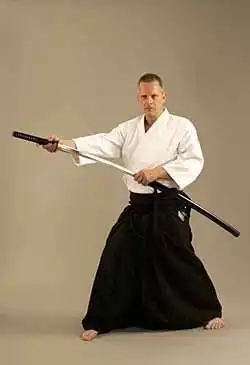
AikibattoIntroductionBackgroundAikibatto BasicsSword exercisesJo staff exercisesSolo video clipsDuo video clipsKen suburiCorrectionsGlossaryVisitor responseShinken, the swordAikibatto — the book
About CookiesMy Other WebsitesCREATION MYTHSMyths in general and myths of creation in particular.
TAOISMThe wisdom of Taoism and the Tao Te Ching, its ancient source.
LIFE ENERGYAn encyclopedia of life energy concepts around the world.
QI ENERGY EXERCISESQi (also spelled chi or ki) explained, with exercises to increase it.
I CHINGThe ancient Chinese system of divination and free online reading.
TAROTTarot card meanings in divination and a free online spread.
ASTROLOGYThe complete horoscope chart and how to read it.
MY AMAZON PAGE
MY YOUTUBE AIKIDO
MY YOUTUBE ART
MY FACEBOOK
MY INSTAGRAM
MY TWITTER
STENUDD PÅ SVENSKA
|
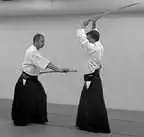 When tori moves left foot forward, toward uke, this is done by a typical budo step, where the foot first goes to the side of the right foot, and from there on forward. This way, tori has a better balance in the step and, as the feet meet, many more possibilities of where to move next.
When tori moves left foot forward, toward uke, this is done by a typical budo step, where the foot first goes to the side of the right foot, and from there on forward. This way, tori has a better balance in the step and, as the feet meet, many more possibilities of where to move next.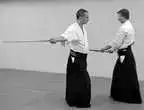 The do cut in movement five, is done when uke is approaching, so that uke is unwillingly helping in the force and speed of the cut. Tori cuts through — with some bokken contact to uke's body, carefully applied — and continues in a wide circular move with the sword, not halting the cut after it has gone past uke's body. Instead the sword moves on to a direction pretty much in right angle to uke's direction, where tori flips the sword 180° around its axis, so that the edge is to the left. From there the sword is pulled up to jodan kamae, the high guard, reaching that position at the same time as tori's body turns toward uke, bringing both feet together, in movement five.
The do cut in movement five, is done when uke is approaching, so that uke is unwillingly helping in the force and speed of the cut. Tori cuts through — with some bokken contact to uke's body, carefully applied — and continues in a wide circular move with the sword, not halting the cut after it has gone past uke's body. Instead the sword moves on to a direction pretty much in right angle to uke's direction, where tori flips the sword 180° around its axis, so that the edge is to the left. From there the sword is pulled up to jodan kamae, the high guard, reaching that position at the same time as tori's body turns toward uke, bringing both feet together, in movement five.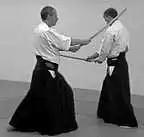 The men cut that follows is done immediately after jodan kamae is reached, preferably in a flowing way that makes the kamae position just something passed through without stop. It is still important to move the sword through the jodan kamae position, or the men cut following would be sloppy, uncontrolled and weak. In that passing moment of the kamae, the sword is positioned by a firm grip with both hands, so that the edge gets in exact line with the following cut.
The men cut that follows is done immediately after jodan kamae is reached, preferably in a flowing way that makes the kamae position just something passed through without stop. It is still important to move the sword through the jodan kamae position, or the men cut following would be sloppy, uncontrolled and weak. In that passing moment of the kamae, the sword is positioned by a firm grip with both hands, so that the edge gets in exact line with the following cut.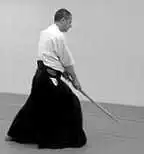 The gedan cut is so deep that the sword stops when the point of it is only a few inches over the floor. The way to do it is not to aim toward the floor, but to really extend the cut forward. Since the arms are stuck to the shoulders, this move will still eventually lead the sword downward, all by itself. One need only to concentrate on the direction forward. This is true with any sword cut, but particularly clear with the gedan.
The gedan cut is so deep that the sword stops when the point of it is only a few inches over the floor. The way to do it is not to aim toward the floor, but to really extend the cut forward. Since the arms are stuck to the shoulders, this move will still eventually lead the sword downward, all by itself. One need only to concentrate on the direction forward. This is true with any sword cut, but particularly clear with the gedan.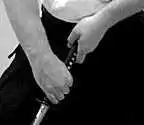 Chiburi with the sword in this low position, the point of it only an inch or so from the floor, is very reasonable to do in the following way. I learned this interesting chiburi from Nishio sensei, and I find it particularly logical when the sword is in a gedan position. I call it chiburi gedan, to indicate that its major activity takes place at that level.
Chiburi with the sword in this low position, the point of it only an inch or so from the floor, is very reasonable to do in the following way. I learned this interesting chiburi from Nishio sensei, and I find it particularly logical when the sword is in a gedan position. I call it chiburi gedan, to indicate that its major activity takes place at that level.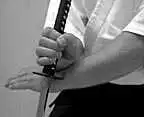 When the sword is pointing to the floor, release the right hand and turn it, grabbing the tsuka anew, this time with the thumb away from the tsuba, the sword guard. Now, flip the sword around its axis, so that the edge points up, while the sword point remains near the floor. Then, release left hand and use it to hit your right wrist from below, so that the sword is suddenly pushed up a bit — this is the actual chiburi, shaking off the blood.
When the sword is pointing to the floor, release the right hand and turn it, grabbing the tsuka anew, this time with the thumb away from the tsuba, the sword guard. Now, flip the sword around its axis, so that the edge points up, while the sword point remains near the floor. Then, release left hand and use it to hit your right wrist from below, so that the sword is suddenly pushed up a bit — this is the actual chiburi, shaking off the blood.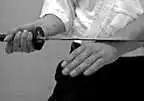 Continuing with the noto, keep the left hand, palm down, on the spot, while the right hand pulls the sword so that the blade comes up in a horizontal position, edge out, and slides on the back of the left hand, out to the right, until the sword point is near the opening of the scabbard. Hold the sword in the air, while the left hand grabs around the opening of the scabbard (or pulls the belt when practicing with bokken), and then let the sword slide into it. Note that when the blade is entered into the scabbard, the right hand grip on the hilt is different from that in chiburi chudan of the two previous exercises.
Continuing with the noto, keep the left hand, palm down, on the spot, while the right hand pulls the sword so that the blade comes up in a horizontal position, edge out, and slides on the back of the left hand, out to the right, until the sword point is near the opening of the scabbard. Hold the sword in the air, while the left hand grabs around the opening of the scabbard (or pulls the belt when practicing with bokken), and then let the sword slide into it. Note that when the blade is entered into the scabbard, the right hand grip on the hilt is different from that in chiburi chudan of the two previous exercises.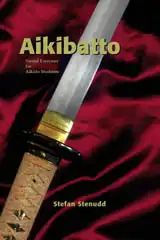 Aikibatto — Sword Exercises for Aikido Students
Aikibatto — Sword Exercises for Aikido Students